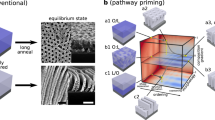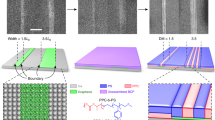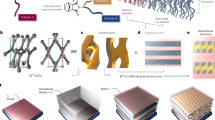Abstract
Self-assembling materials are the building blocks for bottom-up nanofabrication processes, but many self-assembled nanostructures contain defects and lack sufficient long-range order for certain nanotechnology applications. Here we investigate the formation of defects in a self-assembled array of spherical block-copolymer microdomains, using topographical templates to control the local self-assembly. Perfect ordered sphere arrays can form in both constant-width templates and width-modulated templates. For modulated templates, transition between configurations having a constant number of rows and configurations of stable arrays with varying numbers of rows is shown to be analogous to dislocation formation in an epitaxial thin film system. Based on the configuration transition energy and fluctuation energy, designed templates with a high tolerance for lithographical imperfections can direct precisely modulated block-copolymer nanostructures. This study provides insights into the design of hybrid systems combining top-down and bottom-up fabrication.
This is a preview of subscription content, access via your institution
Access options
Subscribe to this journal
Receive 12 print issues and online access
$259.00 per year
only $21.58 per issue
Buy this article
- Purchase on Springer Link
- Instant access to full article PDF
Prices may be subject to local taxes which are calculated during checkout





Similar content being viewed by others
References
Park, M., Harrison, C., Chaikin, P.M., Register, R.A. & Adamson, D.H. Block copolymer lithography: periodic arrays of ∼1011 holes in 1 square centimeter. Science 276, 1401–1404 (1997).
Thurn-Albrecht, T. et al. Ultrahigh-density nanowire arrays grown in self-assembled diblock copolymer templates. Science 290, 2126–2129 (2000).
Cheng, J.Y. et al. Formation of a magnetic dot array via block copolymer lithography. Adv. Mater. 13, 1174–1178 (2001).
Spatz, J.P., Herzog, T., Mobmer, S., Ziemann, P. & Moller, M. Micellar inorganic-polymer hybrid systems- a tool for nanolithography. Adv. Mater. 11, 149–153 (1999).
Black, C.T. et al. Integration of self-assembled block copolymers for semiconductor capacitor fabrication. Appl. Phys. Lett. 79, 409–411 (2001).
Guarini K.W. et al. Low voltage, scalable nanocrystal flash memory fabricated by templated self assembly. IEEE Electron Devices Mtg Tech. Digest, 541–542 (2003).
Ross, C.A. Patterned magnetic recording media. Annu. Rev. Mater. Res. 31, 203–235 (2001).
Maier, S.A. et al. Plasmonics—a route to nanoscale optical devices. Adv. Mater. 13, 1501–1505 (2001).
Morkved, T.L. et al. Local control of microdomain orientation in diblock copolymer thin films with electric fields. Science 273, 931–933 (1996).
De Rosa, C., Park, C., Thomas, E.L. & Lotz, B. Microdomain patterns from directional eutectic solidification and epitaxy. Nature 405, 433–437 (2000).
Segalman, R., Yokoyama, H. & Kramer, E.J. Graphoepitaxy of spherical block copolymer films. Adv. Mater. 13, 1152–1155 (2001).
Cheng, J.Y., Ross, C.A., Thomas, E.L., Smith, H.I. & Vancso, G.J. Fabrication of nanostructures with long-range order using block copolymer lithography. Appl. Phys. Lett. 81, 3657–3659 (2002).
Cheng, J.Y., Ross, C.A., Thomas, E.L., Smith, H.I. & Vancso, G.J. Templated self-assembly of block copolymers: Effect of substrate topography. Adv. Mater. 15, 1599–1602 (2003).
Naito, K., Hieda, H., Sakurai, M., Kamata, Y. & Asakawa, K. 2.5-inch disk patterned media prepared by an artificially assisted self-assembling method. IEEE Trans. Magn. 38, 1949–1951 (2002).
Fasolka, M.J. & Mayes, A.M. Block copolymer thin films: physics and applications. Annu. Rev. Mater. Res. 31, 323–355 (2001).
Fasolka, M.J., Harris, D.J., Mayes, A.M., Yoon, M. & Mochrie, S.G.J. Observed substrate topography-mediated lateral patterning of diblock copolymer film. Phys. Rev. Lett. 79, 3018–3021 (1997).
Rockford, L., Liu, Y., Mansky, P. & Russell, T.P. Polymers on nanoperiodic, heterogeneous surfaces. Phys. Rev. Lett. 82, 2602–2605 (1999).
Kim, S.O. et al. Epitaxial self-assembly of block copolymers on lithographically defined nanopatterned substrates. Nature 424, 411–414 (2003).
Segalman, R.A., Hexemer, A., Hayward, R.C. & Kramer, E.J. Ordering and melting of block copolymer spherical domains in 2 and 3 dimensions. Macromolecules 36, 3272–3288 (2003).
Segalman, R.A., Hexemer, A. & Kramer, E.J. Effects of lateral confinement on order in spherical block copolymer thin films. Macromolecules 36, 6831–6839 (2003).
Matthews, J.W. in Epitaxial Growth (ed. Matthews, J. W.) (Academic, New York, 1975).
Manners, I. Poly(ferrocenylsilanes): novel organometallic plastics. Chem. Commun. 10, 857–865 (1999).
Lammertink, R.G.H., Hempenius, M.A., Chan, V.Z.-H., Thomas, E.L. & Vancso, G.J. Poly(ferro-cenyldimethylsilanes) for reactive ion etch barrier applications. Chem. Mater. 13, 429–434 (2001).
Eitouni, H.B., Balsara, N.P., Hahn, H., Pople, J.A. & Hempenius, M.A. Thermodynamic interactions in organometallic block copolymers: poly(styrene-block-ferrocenyldimethylsilane). Macromolecules 35, 7765–7772 (2002).
Lammertink, R.G.H., Hempenius, M.A., Thomas, E.L. & Vancso, G.J. Periodic organic–organometallic microdomain structures in poly(styrene-block-ferrocenyl-dimethylsilane) copolymers and blends with corresponding homopolymers. J. Polym. Sci. Part B: Polym. Phys. 37, 1009–1021 (1999).
Turner, M.S. Equilibrium properties of a diblock copolymer lamellar phase confined between flat plates. Phys. Rev. Lett. 69, 1788–1791 (1992).
Walton, D.G., Kellogg, G.J., Mayes, A.M., Lambooy, P. & Russell, T.P. A free-energy model for confined block copolymers. Macromolecules 27, 6225–6228 (1994).
Abetz, V., Stadler, R. & Leibler, L. Order–disorder and order–order transitions in AB and ABC block copolymers: description by a simple model. Polym. Bull. 37, 135–142 (1996).
Stadler, R., Auschra, C., Beckmann, J., Krappe, U., Voigt-Martin, I. & Leibler, L. Morphology and thermodynamics of symmetric poly(A-block-B-block-C) triblock copolymers. Macromolecules 28, 3080–3097 (1995).
Pereira, G.G. Confinement of columnar diblock copolymers: simulations, theory and applications. Euro. Phys. J. E 7, 273–289 (2002).
Matsen, M.W. Cylinder↔sphere epitaxial transitions in block copolymer melts. J. Phys. Chem. 114, 8165–8173 (2001).
Matsen, M.W. Cylinder↔gyroid epitaxial transitions in complex polymeric liquids. Phys. Rev. Lett. 80, 4470–4473 (1998).
Kumacheva, E., Golding, R.K., Allard, M. & Sargent, E.H. Colloid crystal growth on mesoscopically patterned surfaces: Effect of confinement. Adv. Mater. 14, 221–224 (2002).
Kumacheva, E., Garstecki, P., Wu, H. & Whitesides, G.M. Two-dimensional colloid crystals obtained by coupling of flow and confinement. Phys. Rev. Lett. 91, 128301 (2003).
Acknowledgements
We thank Henry I. Smith and Mark Mondol for assistance with lithography, J. G. Vancso for polymer synthesis, and E.L. Thomas for discussions. This work was supported by the NSF MRSEC program under award number DMR-0213282, and NSF DMR-0210321.
Author information
Authors and Affiliations
Corresponding author
Ethics declarations
Competing interests
The authors declare no competing financial interests.
Rights and permissions
About this article
Cite this article
Cheng, J., Mayes, A. & Ross, C. Nanostructure engineering by templated self-assembly of block copolymers. Nature Mater 3, 823–828 (2004). https://doi.org/10.1038/nmat1211
Received:
Accepted:
Published:
Issue Date:
DOI: https://doi.org/10.1038/nmat1211
This article is cited by
-
Spontaneous patterning method utilizing transformation of UV-curable emulsion
Scientific Reports (2022)
-
Priming self-assembly pathways by stacking block copolymers
Nature Communications (2022)
-
Asymmetric block copolymer membrane fabrication mechanism through self-assembly and non-solvent induced phase separation (SNIPS) process
Scientific Reports (2022)
-
Formation of nanoparticles from thin silver films under a liquid layer by single-shot nanosecond laser action
Optical and Quantum Electronics (2020)
-
Universal perpendicular orientation of block copolymer microdomains using a filtered plasma
Nature Communications (2019)



